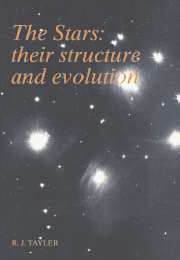Book contents
- Frontmatter
- Contents
- Preface
- Symbols
- Numerical values
- 1 Introduction
- 2 Observational properties of stars
- 3 The equations of stellar structure
- 4 The physics of stellar interiors
- 5 The structure of main sequence stars and pre-main-sequence evolution
- 6 Early post-main-sequence evolution and the ages of star clusters
- 7 Mass loss from stars
- 8 Close binary stars
- 9 Advanced evolutionary phases
- 10 The final stages of stellar evolution: white dwarfs, brown dwarfs, neutron stars and black holes
- 11 Concluding remarks
- Appendix 1 Thermodynamic equilibrium
- Appendix 2 The equation of radiative transfer
- Appendix 3 The pressure of a degenerate gas
- Suggestions for further reading
- Index
10 - The final stages of stellar evolution: white dwarfs, brown dwarfs, neutron stars and black holes
Published online by Cambridge University Press: 05 June 2012
- Frontmatter
- Contents
- Preface
- Symbols
- Numerical values
- 1 Introduction
- 2 Observational properties of stars
- 3 The equations of stellar structure
- 4 The physics of stellar interiors
- 5 The structure of main sequence stars and pre-main-sequence evolution
- 6 Early post-main-sequence evolution and the ages of star clusters
- 7 Mass loss from stars
- 8 Close binary stars
- 9 Advanced evolutionary phases
- 10 The final stages of stellar evolution: white dwarfs, brown dwarfs, neutron stars and black holes
- 11 Concluding remarks
- Appendix 1 Thermodynamic equilibrium
- Appendix 2 The equation of radiative transfer
- Appendix 3 The pressure of a degenerate gas
- Suggestions for further reading
- Index
Summary
Introduction
In the previous discussion of stellar evolution it has frequently been remarked that, so long as the stellar material remains in the form of an ideal classical gas, its central temperature can only increase as it evolves. This result was originally deduced from the Virial Theorem (3.24) on page 55. As I have mentioned on page 201 in Chapter 9, there is at present no completely clear solution to the problem of what happens to a star whose central temperature is still rising at the time that nuclear fusion reactions have converted the central regions to iron, although the association with supernovae of type II seems highly probable; in fact, as I shall explain in the last section of this chapter, the problem can arise even earlier than that. However, if the centre of the star ceases to be an ideal classical gas and becomes a degenerate gas, it is possible that the central temperature may pass through a maximum and that the star may cool down and die. This possibility has already been illustrated for low mass stars in figs. 76 and 86 Such a dying star is likely to have a low luminosity. It is also likely to have a high density. It can only begin to cool down after its central regions have become degenerate and, if the central temperature has previously risen sufficiently for one or more sets of energy-releasing nuclear reactions to occur, a very high density is necessary before degeneracy can occur, as has been seen in Chapter 4 (fig. 45)
Such under-luminous dense stars have been oberved.
- Type
- Chapter
- Information
- The StarsTheir Structure and Evolution, pp. 207 - 219Publisher: Cambridge University PressPrint publication year: 1994



